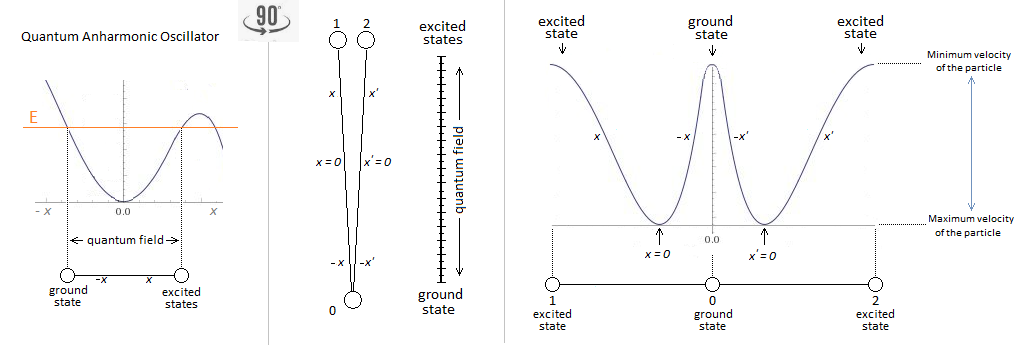-
Posts
569 -
Joined
-
Last visited
-
Days Won
1
Content Type
Profiles
Forums
Events
Everything posted by Kartazion
-
The speed between two is almost instantaneous, even instantaneous.
-
But you, the experts, do you have a mathematical approach to give me for my equation, namely the alternation of a particle from point A to point B? Or does it not exist at all?
-
The movement of the particle along x and t. The equation comes from a university. 11 th line: ressources.univ-lemans.fr/AccesLibre/UM/Pedago/physique/02/meca/oscilanhar.html
-
As I am a beginner in mathematics I do not really know. I thought maybe having help here. Here is how I think to identify the values: Axa (t1) + xb (t2) + Bxc (t1) t1 = 1ns t2 = 1μs xa = -1 xc = 1 xb = -0.99 to 0.99 If we neglect any form of damping the equation of the movement is: m.d2x / dt2 + F.x = 0 (1) There is no analytical solution to the problem and digital integration is required. We use here the Runge-Kutta method at order 4.
-
Split reference: Conclusion: The oscillator that I am trying to exploit is classical and not quantum. Indeed in my case the oscillator allows simply to alternate a particle from point A to point B at high speed. Ultimately, however, it would be difficult to locate the particle at a given fixed point, since the particle is represented on several positions. It is up to me to find the link and the mathematical equation between the classical alternation of a particle and the HUP and the probability of distribution of the particle. _
-

Classical vs. Quantum Harmonic Oscillator (split)
Kartazion replied to Kartazion's topic in Speculations
Yes. All leptons and bosons included? -

Classical vs. Quantum Harmonic Oscillator (split)
Kartazion replied to Kartazion's topic in Speculations
So it starts from the same principle, namely a not specific location, when we trap a photon? -

Classical vs. Quantum Harmonic Oscillator (split)
Kartazion replied to Kartazion's topic in Speculations
I understand. The particle is localized by a probability distribution. -

Classical vs. Quantum Harmonic Oscillator (split)
Kartazion replied to Kartazion's topic in Speculations
The eigenstate interprets the observable states represented by an eingenfunction, which is characterized by a linear operator and its eigenvalue. In the case of the oscillator these eigenstates are measured in a potential well. Position is not an eigenstate. Back to the HUP. The particle identified and located by the uncertainty principle asserts the undeniable presence of particle, right? If yes the particle takes what physical form if it implies a position? -

Classical vs. Quantum Harmonic Oscillator (split)
Kartazion replied to Kartazion's topic in Speculations
So what is the role and the advantage of involving the quantum harmonic oscillator, if there is no oscillating particle? We oscillate the Schrodinger equation as a wave function? Simpler, we oscillate a corpuscle, and not a particle? -

Classical vs. Quantum Harmonic Oscillator (split)
Kartazion replied to Kartazion's topic in Speculations
"One is solving the problem at the quantum level" Which one is solve? "and we use the same terminology as the macroscopic problem" But there is no uncertainty principle at the macroscopic level? -

Classical vs. Quantum Harmonic Oscillator (split)
Kartazion replied to Kartazion's topic in Speculations
Ok. I did'nt understand everything. Could you detail what this means? Which problem precisely? -

Classical vs. Quantum Harmonic Oscillator (split)
Kartazion replied to Kartazion's topic in Speculations
But what does the oscillator oscillate? -

Classical vs. Quantum Harmonic Oscillator (split)
Kartazion replied to Kartazion's topic in Speculations
Sorry, a probability amplitude. It's a probability amplitude into the well? -

Classical vs. Quantum Harmonic Oscillator (split)
Kartazion replied to Kartazion's topic in Speculations
I found that: The ground state energy for the quantum harmonic oscillator can be shown to be the minimum energy allowed by the uncertainty principle. ... This is a very significant physical result because it tells us that the energy of a system described by a harmonic oscillator potential cannot have zero energy. -

Classical vs. Quantum Harmonic Oscillator (split)
Kartazion replied to Kartazion's topic in Speculations
Then the quantum oscillator is only a of probability of presence of the particle in the form of wave, no? It's a wave probability (for to find the particle) into the well? Ok. -
Split reference: When we find a particle with the Schrodinger equation, is it either stationary (fixed position), or in motion with a given velocity with the uncertainty principle?
-
Maybe l should split this thread into one title like: Classical vs. Quantum Harmonic Oscillator No?
-
My speaking time is limited in quantum oscillator since my oscillator is classic?
-
Yes my oscillator remains classic. But then my time is limited for the quantum oscillator?
-
I understand. There is no particle in the quantum oscillator. Or there is a particle without motion? It's the wave that interferes, right? Yes, a principle of me. What does mean pet theory?
-
However ... But it would be like calculating all the interactions of particles at the same time. No, no I know. This is where it gets interesting. This amounts to drawing the wave function with the particle.
-
The oscillator explains a lot. But the oscillator has a trajectory. A trajectory of what? Or at least a periodic charge signal. Yes of course I agree. The oscillator explains it very well with regard to uncertainty. Excited state Vs Ground state. If you only have one particle in action, it is sure that there can be no interactions and interference of itself. Matter is made up of vacuum. In the context of the SM, and for the boson, the principle of reiteration makes it possible to superimpose the "particle" several times in the same place, or at least increase its level of density, at a point.
-
You told me about the electron in the atom, I simply answered you with the photon.
-
Yes it's true, nature is just a wave. But there, if I may allow myself, the quantum decoherence comes into play. Because we can see this photon well, and which by its trajectory, see up to our eye. The photon has a trajectory only if we observe it.


